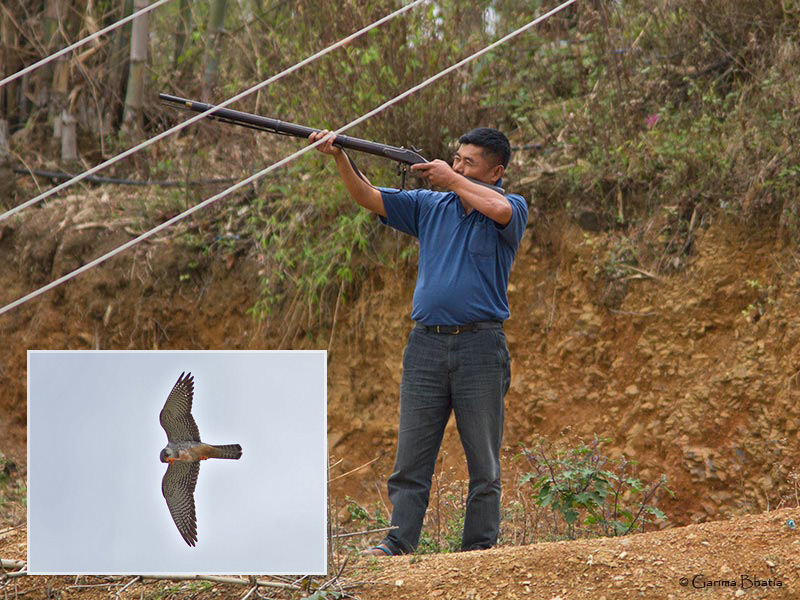
On the 6th of May 2013, Rajneesh Suvarna, Jitendra Bhatia, Suja Rangaswamy and myself were on the way back from Pungro in Eastern Nagaland to Kohima. We had been in Nagaland for 6 days and had noticed that guns were common and hunting accepted as a way of life. The few local Nagas we met were surprised that we had come all the way to watch birds, and indeed were skeptical that we would have seen any. Our birding experience too had been less than ideal, as the birds were extremely skittish, kept their distance, and would disappear before our binoculars could reach our eyes. This wasn’t surprising given the widespread hunting taking place, especially further away from Kohima.
Given this context, we were surprised to see a flock of birds circling low over Kikruma village, just after we crossed Pfutsero, 45 km before Kohima, at around 2.30pm. As we stopped the car and rushed out, a wave of excitement passed through us as we realized that these were Amur Falcons (Falco amurensis), presumably on their return migration back to their breeding grounds in Central Asia. We clicked away and a quick count showed up 16 birds. They appeared to be swooping and hunting dragonflies, and we could observe them feeding in mid-air (image inset).
A small crowd of kids soon gathered around us, just out of school for the day. Seeing our obvious interest in birds, one of the kids proudly revealed a female Grey Bushchat he was holding, and whose legs he had already broken. Another friend of his held out a perfect blue egg in his palm, belonging to the Bushchat. We tried to tell them to release the bird, but the kids understood no Hindi or English, so any attempt at communication was futile. We turned our attention back to the falcons, when Suja noticed a man on the adjacent hill, taking aim at the Amurs with his rifle. Our exultation at the Amurs sighting quickly turned to horror and rage, and we started screaming across the hill, asking him not to shoot.
The commotion may have spooked the falcons, as they quickly disappeared, while our hunter noticed us frantically gesticulating and screaming, lowered his rifle, and smiled for our cameras. Clearly, the hunter and the kids seemed to be bemused at our behaviour, and the thought that it might be wrong (illegal, really) to hunt birds – resident or otherwise – had not even crossed their minds. We made a few phone calls to friends who could advise us on the next course of action, and were told that the best (and least) we could do was to write about the incident.
On the rest of the journey we vented our frustrations, and discussed what in our opinions were possible solutions to end the killing. We hoped that with younger people getting educated outside the state, some amount of environmental awareness might set in. However with a hunting culture so deeply entrenched, any kind of education/awareness initiatives would take time to bear fruit, and we fear that by then the double whammy of wanton hunting by an exploding population coupled with habitat destruction due to the practice of jhum (slash-and-burn) cultivation would sound the death knell for several unique species, unless immediately redressed through some kind of state intervention.
Conservation India will report this incident to senior officials in Nagaland. Post CI’s expose of the mass slaughter of migrating Amur Falcons in Wokha district last October, a dedicated team has been working with both officials and the local community to wean them away from hunting the migratory raptors.

 CI is a non-profit, non-commercial portal that aims to facilitate wildlife and nature conservation by providing reliable information and the tools needed to campaign effectively.
CI is a non-profit, non-commercial portal that aims to facilitate wildlife and nature conservation by providing reliable information and the tools needed to campaign effectively.
Chosen as 'Picture of the Week'
In Nagaland, with a hunting culture so deeply entrenched, any kind of education/awareness initiatives would take time to bear fruit, and we fear that by then the double whammy of wanton hunting by an exploding population coupled with habitat destruction due to the practice of jhum cultivation would sound the death knell for several unique species, unless immediately redressed through some kind of state intervention.